Tired of shelling out big bucks for pre-cut filet mignon at the store? What if you could unlock the secret to cutting and cooking restaurant-quality filet mignon right at home—for a fraction of the cost?
Why This Guide Matters
This is your masterclass in handling beef tenderloin like a pro. You’ll learn how to break down a whole beef tenderloin, identify and extract the prized center cut, and then transform those filets into perfectly cooked, tender steaks. Whether you’re nervous about ruining an expensive cut or just want to up your grill game, we’ve got you. Butchering your own tenderloin isn’t just a money-saver — it’s a serious flex.
What You’ll Gain
By the end of this guide, you’ll:
- Know how to butcher a whole tenderloin into premium steaks
- Understand what makes center cut filet mignon so special
- Learn to cook filet mignon with confidence and precision
- Save money while impressing everyone at your dinner table
What is Center Cut Filet Mignon?
Definition: The center cut is the most uniform, tender, and desirable portion of the beef tenderloin.
Location: Found in the middle of the whole tenderloin, between the head (butt) and the tail.
Why It’s Premium: Consistent shape and exceptional tenderness make it ideal for filet mignon.
Comparison to Other Parts:
| Cut Name | Location | Characteristics | Common Uses |
|---|---|---|---|
| Center Cut | Middle section | Uniform, lean, very tender | Filet Mignon, Chateaubriand |
| Head (Butt) | Thick end | More fibrous, uneven | Roast, Beef Wellington, Tips |
| Tail | Tapered end | Smaller, thinner | Stew, Stir-fry, Stroganoff |
👉 Want to understand how beef quality is officially ranked? The USDA Beef Grading Guide breaks down what Prime, Choice, and Select really mean.
According to the USDA’s beef grading standards, Prime and Choice grades offer superior marbling — exactly what you’re looking for in tenderloin.
How to Butcher a Whole Beef Tenderloin (Step-by-Step)
1. Prep the Tenderloin
- Slightly chill the tenderloin for easier trimming.
- Pat dry and place on a stable cutting board.
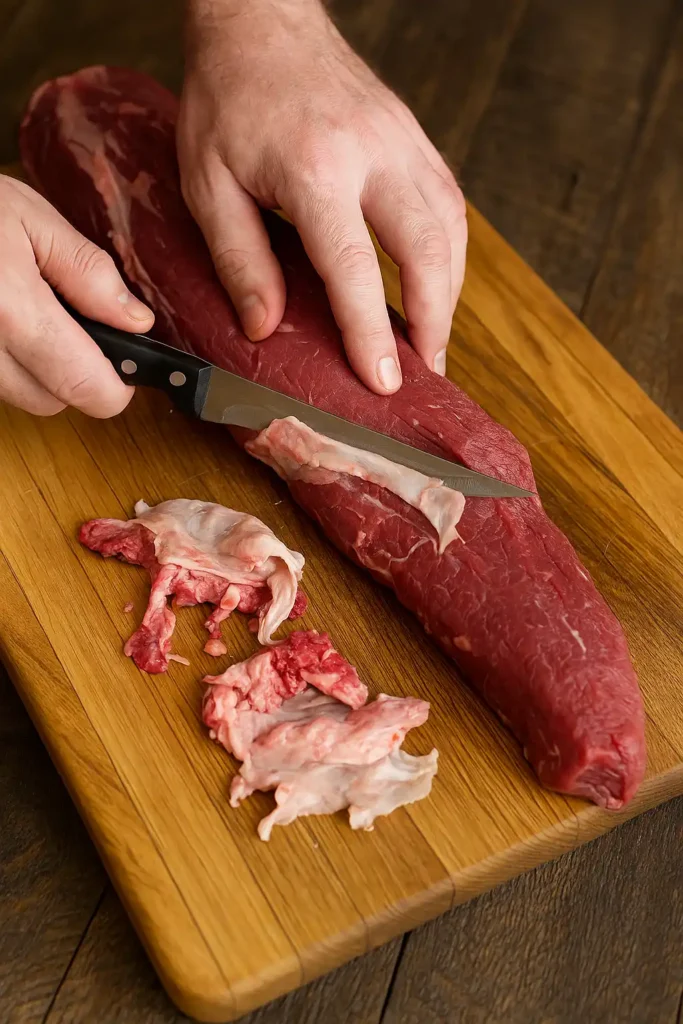
2. Remove the Fat & Chain
- Identify the thick fat cap and carefully trim it away.
- Detach the “chain” muscle running along the side.
3. Remove the Silverskin
- Use a sharp boning knife at a shallow angle.
- Keep the blade under the silverskin and pull it taut as you trim.
4. Locate the Center Cut
- Look for the section with uniform diameter.
- Cut off the head and tail cleanly.
5. Slice Filets
- Cut 1.5–2 inch thick steaks.
- Use clean, smooth cuts for even thickness.
6. Trim & Tie
- Tidy any rough edges.
- Use kitchen twine if needed to maintain round shape.
7. Store Your Filets
- Wrap in plastic or vacuum seal.
- Refrigerate or freeze appropriately.
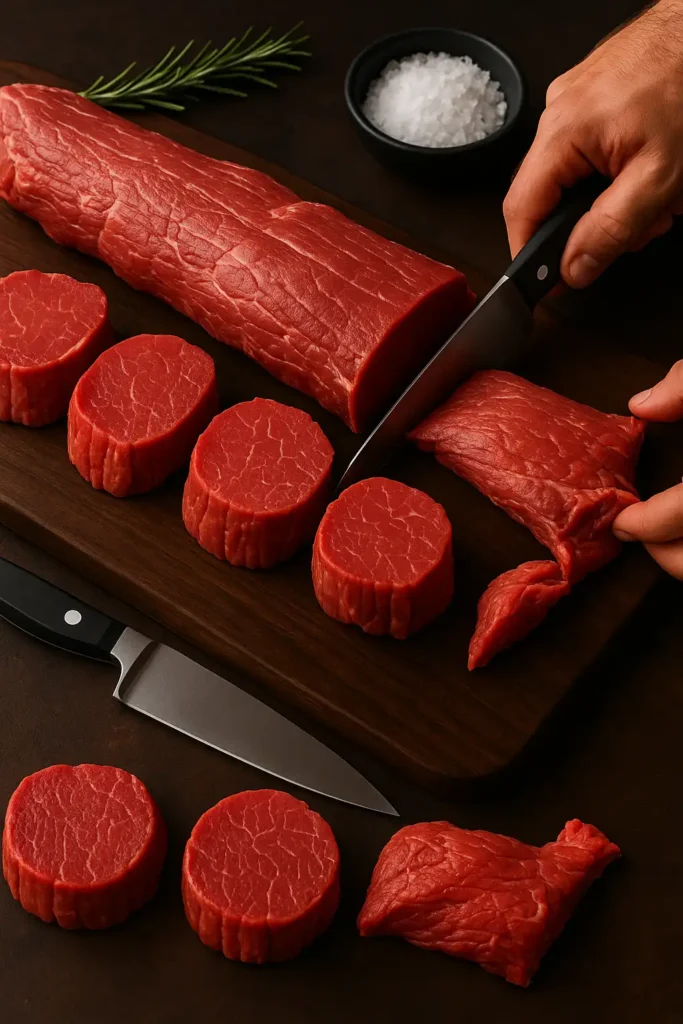
Quick Reference Table:
| Step | What to Do | Key Tip |
|---|---|---|
| Prep | Chill and dry the tenderloin | Cold meat is easier to handle |
| Trim Fat/Chain | Remove fat and chain muscle | Keep knife close to the meat |
| Silverskin | Remove with shallow cuts | Don’t rush this step |
| Isolate Center | Cut away head and tail | Look for symmetry |
| Portion | Slice into 1.5″–2″ steaks | Consistent size = even cooking |
| Shape | Trim and tie if needed | Round filets cook evenly |
| Store | Wrap properly | Use airtight methods for freshness |
Must-Have Tools
| Tool | Purpose | Why It’s Essential |
|---|---|---|
| Boning Knife | Trimming fat/silverskin | Precision, safety, less waste |
| Chef’s Knife | Cutting steaks | Clean, uniform slices |
| Cutting Board | Butchering surface | Prevents slipping, supports size |
| Thermometer | Measure doneness | Precision = perfect steaks |
| Cast Iron Skillet | Searing | Holds heat for crusty exterior |
| Kitchen Twine | Tying filets | Holds shape during cook |
| Butcher’s Steel | Maintain knife edge | Sharp knife = safer cuts |
🧠 Pro Tip: Keep your blades sharp and your thermometer calibrated.
Cook Center Cut Filet Mignon (Reverse Sear Method)
🔥 Why Reverse Sear?
You get an even cook from edge to center — with a beautiful crust at the end.
The key to filet perfection isn’t just technique — it’s control over temperature.
🌡️ Rest Time: 5–10 min
Salt steaks generously on all sides. Let rest at room temp for 30–60 min.
Preheat oven to 250°F (120°C).
Place steaks on wire rack over a baking sheet.
Roast until internal temp hits 115°F for medium-rare (about 30 min).
Heat cast iron skillet until smoking hot. Add oil.
Sear steaks 1 min per side, then quickly sear edges.
Add butter, garlic, and herbs. Baste steaks for 30 seconds.
Let rest 5–10 min before slicing or serving.
Ingredients
Directions
Salt steaks generously on all sides. Let rest at room temp for 30–60 min.
Preheat oven to 250°F (120°C).
Place steaks on wire rack over a baking sheet.
Roast until internal temp hits 115°F for medium-rare (about 30 min).
Heat cast iron skillet until smoking hot. Add oil.
Sear steaks 1 min per side, then quickly sear edges.
Add butter, garlic, and herbs. Baste steaks for 30 seconds.
Let rest 5–10 min before slicing or serving.
Notes
🌡️ Rest Time: 5–10 min
Temperature Guide
| Doneness | Internal Temp | Approx. Time (Each Side) |
|---|---|---|
| Rare | 120-125°F / 49-52°C | 2–3 min |
| Medium Rare | 130-135°F / 54-57°C | 3–4 min |
| Medium | 140-145°F / 60-63°C | 4–5 min |
| Medium Well | 150-155°F / 66-68°C | 5–6 min |
| Well Done | 160°F+ / 71°C+ | 6+ min |
⚠️ Tip: Use a meat thermometer—not guesswork—for accuracy.
How to Use a Thermometer
- Insert into thickest part of the steak
- Avoid touching fat or bone
- Start checking 1–2 minutes before expected doneness
Need a reliable meat thermometer?
We recommend ThermoWorks for fast, accurate readings — a must when cooking pricey cuts like filet.
Common Problems & Fixes
- No sear/crust → Skillet not hot enough
- Overcooked → Reduce oven time or check temp earlier
- Uneven doneness → Adjust based on steak size
Q: What is center cut filet mignon?
A: It’s the most tender and uniform section of the beef tenderloin, located between the head and tail. It’s prized for its consistent shape and buttery texture.
Q: Is it cheaper to butcher your own tenderloin?
A: Absolutely. Buying a whole tenderloin and trimming it yourself can save you 30–50% compared to buying pre-cut filets — plus you get usable scraps for other dishes.
Q: What’s the best way to cook center cut filet mignon?
A: The reverse sear method is ideal. It gives you edge-to-edge doneness with a crisp, flavorful crust — perfect for thick cuts like filet.
Q: Can I freeze trimmed filet mignon steaks?
A: Yes. Wrap them tightly in plastic wrap, vacuum seal if possible, and freeze for up to 3 months for best quality.
Alternate Cooking Methods (and When to Use Them)
| Method | What It Is | Best For | Caution |
|---|---|---|---|
| Reverse Sear | Slow cook then sear | Thick cuts, edge-to-edge pink | Takes more time |
| Grilling | High heat sear | Smoky flavor, outdoor cook | Needs hot zones |
| Sous Vide + Sear | Water bath precision | Ultra tender, exact temp | Requires equipment |
| Broiler | Oven top-down heat | Simple indoor crust | Monitor closely to avoid burning |
🔥 Expert Pick: Reverse sear gives the best crust and control for thick center-cut filets.
🧊 What About Leftovers & Scraps?
Don’t toss the tail, tips, or chain meat. Here’s how to use them:
- Tenderloin Tips: Quick-sear for steak salad or steak tacos
- Tail End: Great for stir-fry or skewers
- Chain Meat: Grind for epic burgers or meatballs
➡️ Stay tuned — a full guide to “Using Every Cut of the Tenderloin” is coming soon.
Wrap-Up: From Whole Tenderloin to Plate Hero
Filet mignon is often seen as a “fancy steak,” but with a whole tenderloin and the right approach, you can butcher and cook it better than any overpriced steakhouse. This masterclass gives you the tools — all you need now is practice (and maybe a glass of red).You’ve now got the skills to turn a whole beef tenderloin into beautifully trimmed, center cut filet mignon steaks—and the confidence to cook them like a pro. Whether you’re prepping a holiday dinner or just want to elevate your weeknight meal, you’re not just saving money—you’re mastering your craft.
Remember: You’re not just cooking a steak—you’re crafting an experience.
Want more pro-level meat tutorials?
👉 Browse our Butchering Tips section or dive into our How to Grill Ribeye Steak on a Charcoal Grill (Like a Pro) for more sizzling skills.
How to Use a Charcoal Chimney Starter
👉 “Before you light up that cast iron skillet, make sure your grill setup is dialed in. Check out our step-by-step guide on using a charcoal chimney starter to get clean, even heat every time.
How to Grill on a Charcoal Grill Like a Pro
👉 “Once you’ve mastered filet indoors, level up your game with our full tutorial on grilling like a pro with charcoal



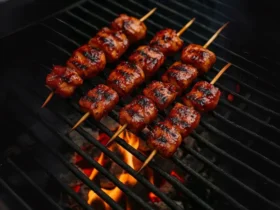
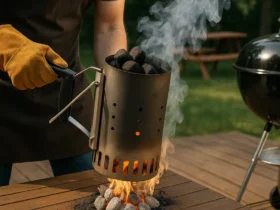




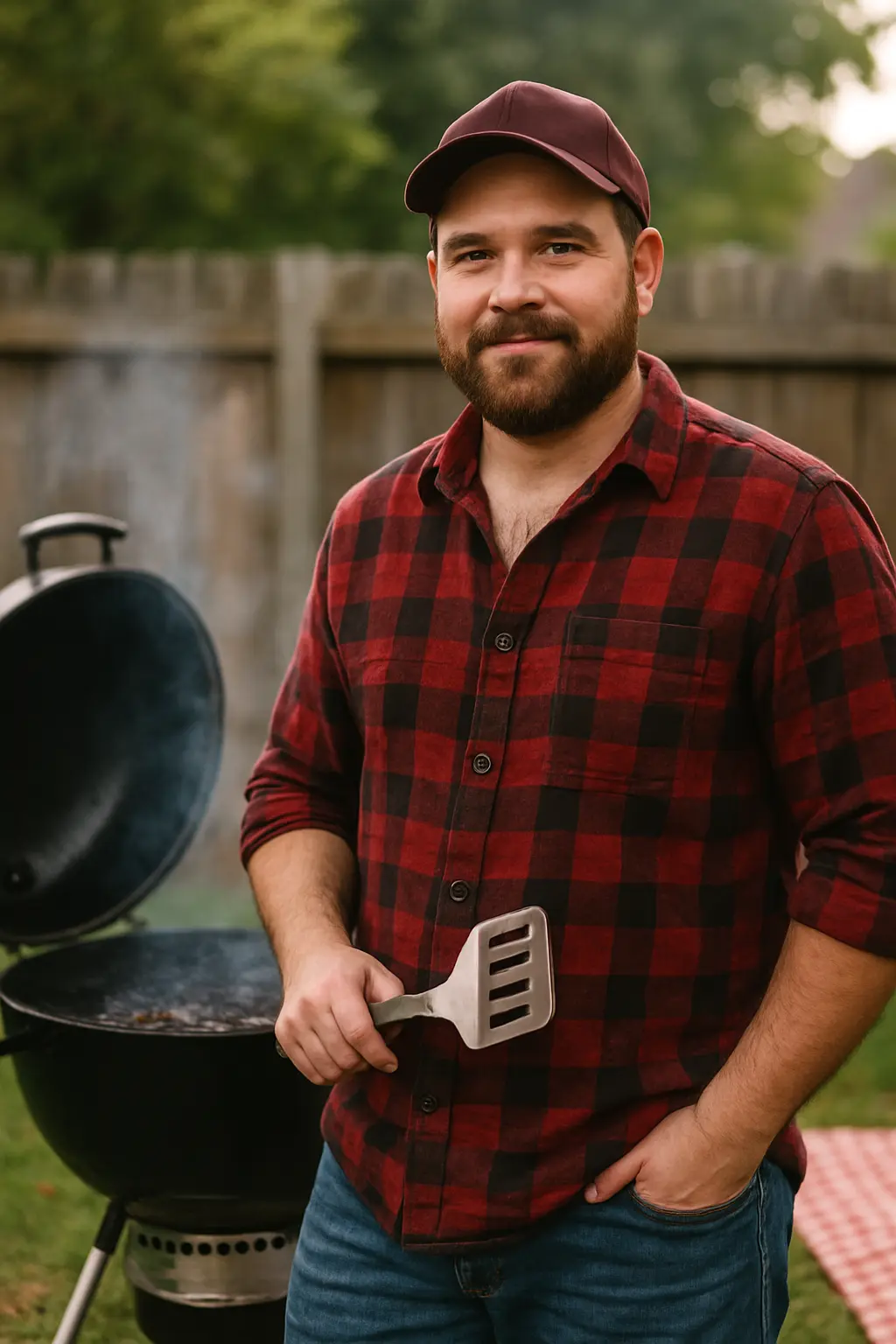
Leave a Reply